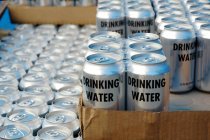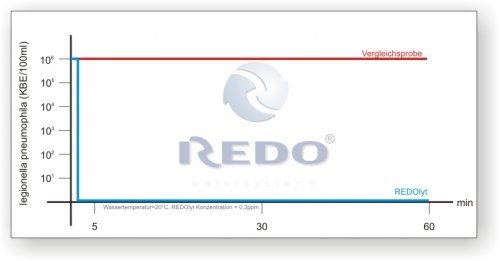Legionella
Disinfection and Prevention
Legionella bacteria are heat-loving bacteria. They can cause an infectious disease associated with symptoms of pneumonia. In 1976, the previously unknown infectious disease in occured at Legionnaires' convention in Philadelphia and has since been known as Legionnaires' disease or Legionella pneumophila. Legionella can also cause even the so-called Pontiac fever.
Legionella bacteria grow preferably between 25 and 40 ° Celsius. Typical sources are especially showers, swimming pools and air conditioning with humidifiers, i.e. places where water is not heated to high temperatures and not circulated for prolonged periods. Water storage facilities with more than 300 litres capacity are also vulnerable. All water not circulated for prolonged periods and warmer than 25 ° Celsius (so-called stagnant water) is a suitable environment for Legionella to develop.
Due to a request in the Berlin House of Representatives in March 2011, it was found that in fifty percent of Berlin hospitals Legionella was found in drinking water since 2005. For healthy people, the pathogens are mostly harmless. However, in people with weaker immune system these pathogens can cause serious infections.
In DVGW leaflet W 551 (2004) and on recommendation of the Federal Environment Agency in 2006 low Legionella and germs concentrations in Building are listed as desirable, which require measures and immediate action to prevent risk of infections.
Legionella concentrations of less than 100 cfu/100 ml are considered a desired target threshold. Between 100 and 1000 cfu/100 ml it needs to be ensured through four-week test that no further increase in concentration takes place. > 1000 cfu/100 ml is the threshold where counter measures reducing the concentration are required. The threshold of > 10,000-cfu/100 ml requires immediate emergency measures, such as a ban to shower. In high-risk environments where people with weak immune system are treated such as hospitals s, Legionella must not be present.
REDO technology has proven to be particularly effective against Legionella. It is a highly effective and safe to use disinfectant, disinfecting contaminated raw water quickly and reliably. Furthermore, due to the depot effect it prevents that water systems are contaminated again after they are disinfected. Since REDO Technology also eliminates existing biofilms REDO Technology offers a high prophylactic protection against Legionella, particularly in sensitive environments such as hospitals and nursing homes.
Cooperation
Clean Water Fund

INWASOL and the Clean Water Fund have developed a special solution for water projects:
Due to a strong partnership with the Clean Water Fund, INWASOL is not only able to provide its customers with an innovative German water disinfection technology, but also with several financing solutions.
We are looking forward to your inquiry. There is a suitable solution for every customer.

